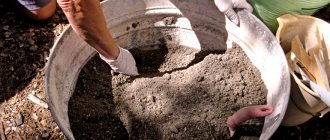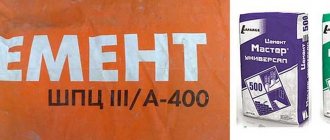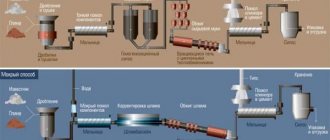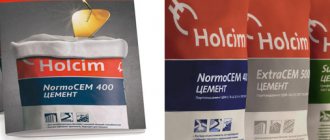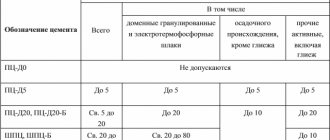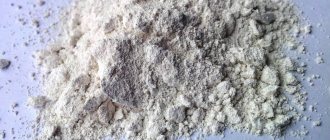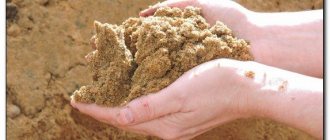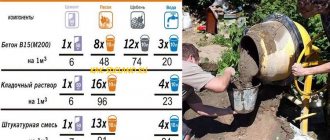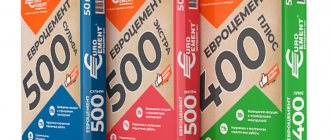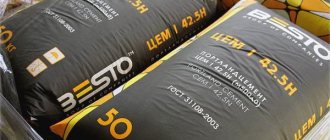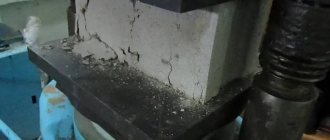Cement is a binding powder used for the manufacture of building materials, buildings and other structures. It is made from clinker, limestone, various minerals and gypsum. The area of use, characteristics and properties of cement depend on the composition and proportions of the components. The most common is Portland cement. To produce it, limestone is added to clay.
Characteristics of cement powder
The cement structure, which has already hardened, is constantly exposed to the environment. So, if it is located on the street, then precipitation and salts fall on it. It freezes and thaws. To improve corrosion resistance, polymer additives are added to the cement powder at the production stage. They reduce the degree of microporosity, making the material more reliable.
Not only the price of the binder component, but also its quality depends on such a parameter as the fineness of grinding. The smaller the fraction, the better the source material. The hardening process of fine Portland cement occurs much faster than powder with large particles. To ensure that cement has optimal characteristics, different fractions are mixed.
One of the main parameters that you should pay attention to when choosing Portland cement is the degree of frost resistance. The more freezing and thawing cycles it can withstand, the longer the structure built from it will last, and the less repairs it will require. The scope of application of cement completely depends on this characteristic. Every time concrete freezes, the water it contains expands and breaks it down from the inside. To improve the degree of frost resistance, mineral additives are added to the cement powder, for example, sodium abietate or neutralized wood pitch.
Cement also differs in strength. To determine the grade, a solution is prepared from one part of cement powder and three parts of quartz sand. Everything is thoroughly mixed to a homogeneous consistency and poured into the mold. After 28 days, the test sample is placed under a press and pressed. The pressure at which it began to collapse is its mark. To determine it, 6 probes are tested. The arithmetic average is calculated from the 4 best. The result obtained is considered its brand in terms of strength. This indicator is measured in MPa and kg/cm2.
Another characteristic on which the area of application of cement powder depends is the setting time. This parameter is especially important in conditions where emergency repairs are required or in cold climates. The rate of hardening of Portland cement can be controlled using gypsum or other additives. Ambient temperature and water also influence. The colder the air, the longer the cement hardens. Under optimal conditions and proper mixing, the cement mortar sets in 45 minutes.
No. 1. Main types of cement
Cement is an inorganic binder. Cement powder, when interacting with water, forms a plastic mass that quickly sets and forms a stone-like body. It is often used to make concrete and mortars. The composition of cement can vary greatly. Accordingly, the properties and scope of use will differ.
Today the following main types of cement are produced:
- Portland cement – the most popular type of cement in construction. It is made from Portland cement clinker, gypsum and special additives. Clinker is produced from limestone, clay and additives by firing. Ready-made Portland cement consists of 70-80% calcium silicates, the rest is gypsum (regulates the setting speed) and corrective additives. Portland cement is produced in grades M400-M600 and is used to create reinforced concrete structures, mortars, asbestos-cement and other materials. Not suitable for the construction of structures exposed to sea water;
- white Portland cement is made from gypsum, diatomite and clay-sand rocks with a minimal content of coloring substances. The result is a composition with high strength, weather resistance and rapid setting. Only two brands are produced: M400 and M500. The composition is often used for external finishing work, as it has an aesthetic appearance and is not susceptible to cracking. It is used for the manufacture of decorative elements (statues, columns), for the organization of self-leveling floors, in road construction, and in facade finishing works. Colored compositions are made based on white Portland cement ;
- sulfate resistant Portland cement produced on the basis of Portland cement clinker and gypsum. The composition is characterized by a reduced content of calcium aluminates, which ensures resistance to sulfates. Cement can be without additives or have additives in the form of granulated slag. Brand M400 and M500. It is used in the creation and construction of structures that will be operated under the influence of mineralized waters. This cement is used in the manufacture of piles, bridge supports, and in the construction of external elements of hydraulic structures;
- pozzolanic Portland cement is obtained from Portland cement clinker, gypsum and additives of sedimentary origin, some of which make up 20-30%. The composition is resistant to fresh and sulfate-containing waters and waterproof. Among the disadvantages are low frost resistance and low hardening speed. Used in pouring foundations and laying basements of industrial and civil buildings, in the construction of subways, mines, canals, sluices, water supply lines;
- slag cements – a group of cements that includes slag Portland cement (SPC) and lime slag cement (ISC). The first is produced on the basis of Portland cement clinker, gypsum and blast furnace slag, part of which is 21-60%. The composition is characterized by a slow increase in strength, increased resistance to aggressive environments, but is not resistant to temperature changes. Used in hydraulic engineering construction. ISC is obtained from a mixture of slag and lime (its part is about 30%), small additions of gypsum and Portland cement are allowed. The composition hardens slowly, is most resistant in fresh and sulfate waters, can be used for the production of low-quality concrete, in mortars for plaster and masonry;
- quick-hardening Portland cement , as the name suggests, is characterized by a rapid increase in strength in the first hours of hardening. These properties are explained by the precise selection and dosage of special additives. As a result, the composition reaches its ultimate strength within 3 days, which speeds up the production process of reinforced concrete structures;
- Aluminous cement is also characterized by a high rate of hardening and strength gain. It is produced on the basis of bauxite or alumina with the addition of limestone. Based on the alumina content, ordinary (up to 55% alumina), high-alumina (up to 65%) and high-purity high-alumina cements are distinguished. The compositions are highly resistant to fire, corrosion and rapidly increase in strength. This cement has found application in emergency work, high-speed construction and winter concreting;
- expanding cements – a group of cements that are characterized by an increase in volume during hardening. A similar effect is achieved through a reaction between the powder and water, resulting in the formation of calcium hydrosulfoaluminate, a substance that can bind large amounts of water. The group of expanding cements includes waterproof, tensile, gypsum-alumina compounds and expanding Portland cement. Let's look at them all separately;
- Waterproof expansive cement is made from gypsum, alumina cement and calcium hydroxide aluminate. The composition begins to set after 4 minutes, and after 10 minutes the hardening process ends. Used in underground and underwater construction, for sealing cracks and when creating monolithic structures from individual prefabricated reinforced concrete elements;
- Tensile expanding cement is made from Portland cement clinker, lime, aluminous slag and gypsum stone. The composition hardens relatively quickly and is waterproof. Used in concreting swimming pool bowls and in the production of pressure pipes;
- gypsum alumina expanding cement made from aluminous blast furnace slag and gypsum. The composition sets within 4 hours, expansion ends after 3 days. Cement is characterized by high frost resistance, strength and deformation resistance. It is used to carry out waterproofing work;
- Expanding Portland cement is a mixture of Portland cement clinker, high alumina slag, gypsum and mineral additives. Depending on the composition, the expansion ranges from 0.3 to 2.5%. The expansion period is long, so the volume is filled evenly. Used in the construction of road surfaces and repair of hydraulic structures;
- Well cement is used only when plugging oil and gas wells in order to isolate them from groundwater. Made from clinker and gypsum;
- hydrophobic cement , in addition to gypsum and clinker, contains oleic acid or other hydrophobic substances that make it possible to create a waterproof film on the surface of dried cement. This cement is ideal for foundations;
- magnesia cement differs in the content of magnesium oxide, which increases the elasticity of the composition and its resistance to aggressive substances. Used in flooring;
- waterproof non-shrinking cement is produced on the basis of aluminous cement, gypsum and slaked lime. The composition sets quickly and is not afraid of water;
- acid-resistant quartz cement is a product of mixing quartz sand, sodium silicofluoride and liquid sodium glass. The composition is resistant to aggressive substances, but loses strength in water;
- cement with surfactant additives has increased mobility and is used when working on complex objects from an architectural point of view.
General information
Cement (in Latin caementum), translated as “broken stone” or “crushed stone”. You get it like this:
- Cement is prepared from sludge, the raw materials for which are two main components - 25% clay and 75% ground limestone.
- Next, clinker is formed, for which the finished slurry is fired at a temperature of +1450…+1480 °
C. - The resulting solid mass (clinker) is crushed into a gray powder, to which mineral additives and gypsum are then added.
As a result, an artificially created building material is born, which, interacting with water and other liquids, turns into a plastic substance, and when hardened, forms a stone-like body.
Important! The ability of cement to gain strength when interacting with liquids is unique, and this fundamentally distinguishes this material from other cementitious materials, such as gypsum or air lime, which harden only in air.
No. 2. Cement grades by strength
The most important characteristic of any type of cement is its strength. This indicator is determined experimentally: prepare a solution from cement and sand in a ratio of 1:3, create a sample in the shape of a parallelepiped with sides 40*40*160 mm. The resulting sample is subjected to gradually increasing load. The experiment is slightly different only for some types of cement.
The data obtained during laboratory research is reflected in the stamps. If the sample can withstand a load of 300 kg/cm2, then it is brand M300, 500 kg/cm2 - M500, etc. The grades are designated by the letter M and the subsequent index from 200 to 600 in increments of 50 or 100. The higher the grade, the more durable the composition we have, and the more durable and high-quality concrete it will produce:
- for the foundation use cement grade M400-M500;
- cement M200-M300 is suitable for finishing work
- cement brand M600 is called military, it has increased strength, costs much more than M500 and is used in the construction of bunkers and other military facilities.
Today, along with the classification of cement by strength grade, a division into strength classes . If the brand is an average indicator, then the class is more accurate and provides a 95% guarantee of compliance with the specified data. Strength classes vary from 30 to 60:
- 52.5 – cement withstands pressure of 52.5 MPa, corresponds to cement grade M600;
- 42.5 corresponds to M500 cement;
- 32.5 corresponds to M400 cement;
- 22.5 corresponds to M300 cement.
Application area
Cement is the main component of cement-sand and concrete mortar, due to which it is used in the following structures:
— Construction industry: production of monolithic and reinforced concrete structures necessary for the industrial construction of buildings and engineering structures (public buildings, multi-storey buildings, bridges, dams, etc.);
— Private construction: construction of the foundation of a private house, finishing work, construction of fences and foundations for them;
— Road industrial construction: construction of fender structures, runways, port berths, etc.
— Structures operating in complex and aggressive environments: bridge supports and all kinds of their own, installed in an environment with a high level of acids, in salt water or in conditions of repeated freezing/thawing.
— Extractive industry: strengthening of structures, as well as plugging of oil and gas wells.
No. 4. Marking by speed of strength gain
The time it takes for cement to reach its maximum strength is another important compositional indicator. In some cases, it is required that it hardens instantly, in others, on the contrary, an excessive rate of strength gain will only cause harm. According to this parameter, cement is divided into the following types:
- CEM V – normal-hardening cement with a compressive strength of 32.5 MPa;
- CEM IV is a normal-hardening pozzolanic cement with a strength of 32.5 MPa. The composition may contain silica, pozzolans (21-35%);
- CEM III – normal-hardening Portland slag cement with a slag content of 36-65% and a strength of up to 32.5 MPa;
- CEM II is characterized by different hardening rates, which depend on the amount and composition of additives;
- CEM I is cement with the highest setting speed. The next day, the strength already reaches 50% of the design value.
Other physical and mechanical properties
Among all the quality indicators of cement, to carry out various calculations, it is most often necessary to know its bulk density. This parameter depends on the friability of the particular material. If the cement is just received from the manufacturer, its friability is maximum and the bulk density is taken as 1100 kg/m³. After a long period of storage, even in a dry room, the powder material may cake. Then its bulk density reaches 1500-1600 kg/m³. The average value of this indicator for calculations is taken as 1300 kg/m³.
No. 5. What else could be in the marking of cement?
In the characteristics of the composition, after the designation of the cement brand and the percentage of additives, there may be various abbreviations indicating the specific qualities of the cement:
- SS is a sulfate-resistant cement;
- GF – hydrophobic cement;
- B – quick-setting cement;
- PC – Portland cement;
- BC – white cement;
- N – standardized cement, which is produced from clinker and has a standardized composition;
- PL – plasticized cement with high frost resistance;
- VRC is a cement with a high setting speed and expansion during hardening.
How to make cement mortar
To prepare cement mortar, you will need cement itself, water and filler (for plaster and masonry mortars, river or quarry sand is used).
The ratio of ingredients in the solution depends on the use of the material, but in most cases it is recommended to use the formula: 3 parts sand to 1 part cement. Water is added based on the need to obtain a more plastic or viscous solution.
If you want to obtain a structure with higher strength characteristics, increase the proportion of cement. It is correct to start preparing the solution by mixing the dry fractions, and only after obtaining a homogeneous mass do they begin to pour in water in small portions, gradually achieving the required consistency.
No. 6. What to look for when choosing cement?
The demand for cement is enormous, which has given rise to the emergence of many unscrupulous manufacturers who often mix additives into cement that greatly reduce the quality of the finished composition. In order not to make a mistake when choosing cement and to buy a really high-quality product, you need to know something about what good cement looks like and what properties it should have:
- cement is sold in bags and in loose form. It is better to take cement in bags, since this way it is protected from external influences, retains its qualities longer, and on the packaging of the bag you can always find out information about the composition, production date, characteristics of the cement and its manufacturer. The bags are usually made of two layers of paper, the inner one protects the cement from getting wet. By the way, the absence of any information on the packaging is also a sign that you may have low-quality material;
- If you buy cement in bulk and it is packaged in bags, then it is better to carefully check the expiration date on each one, since they may sell you stale goods in the bulk. The activity of cement drops several times after 6 months from the date of production;
- check the freshness of cement experimentally. It is enough to hit the bag - the sensation should not resemble hitting a stone. The cement in the corners of the bag hardens first, so it doesn’t hurt to check them either. Naturally, if there is no production date on the packaging at all, then it is better not to buy such a product;
- cement should be stored in dry and well-ventilated areas, otherwise it will quickly turn to stone;
- The color of high-quality cement is gray, more precisely from light gray to dark gray and even greenish. Dark and marshy shades are not allowed. Good cement should crumble in your hand and not crumple into a lump when squeezed;
- The fineness of grinding affects the curing process. The finer the particle fraction, the faster the composition will harden and the higher its price. Too fine a fraction increases water consumption, so ideally it is better to take cement where fractions from 40 to 80 microns are found;
- does not interfere with carrying out assessment of cement composition and characteristics. This is not difficult to do, but you need to prepare sodium bicarbonate water in advance (Borjomi will do) or sodium bicarbonate chloride water. Gas must be released from the water. Next, we use it to knead cement dough and form it into a cake with a diameter of 15 cm. It should be thicker in the center (5 cm), narrower towards the edges (1 cm). High-quality cement should begin to set no later than after 10 minutes, and the thickened part will noticeably heat up. If setting does not occur even within 30 minutes, then you have a composition of low quality.
Types of counterfeit bags using designations that are confusingly similar to the trademarks of Eurocement Group JSC
